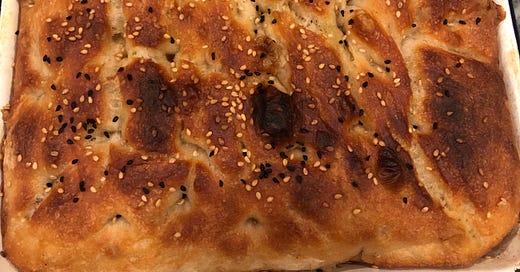Basic yeasted focaccia. This is the bread I make most often at home, especially in the summer when I have less time and patience to fuss with sourdough. As much as I love sourdough, I am not a purist about it, and I think there are plenty of situations where yeasted bread is better than sourdough. Focaccia is one of them. The flavour of sourdough is richer but I prefer the texture of a yeasted focaccia- it is softer and lighter and happier to play a supporting role rather than a main character, perfect for sandwiches, dips or croutons.
I love this recipe because it is really versatile. Sometimes I top it with nothing but flakey salt, while other times I use a blend of seeds and spices, such as sesame and nigella seeds or an everything bagel seasoning. Often I will top this with seasonal veggies and a little cheese, maybe a few herbs or chili flakes thrown on, eaten as an easy breakfast or at lunch on the side of a salad.
This particular recipe requires so little attention that there is really nothing to stop you making it several times a week if need be. The only thing really required is a little space in your fridge as it is required to sit in the fridge for a day or two to develop flavour. I use a rectangular commercial kitchen container that fits snuggly in the side of my refrigerator. The shape makes it especially easy for me to just tip it into the baking tray, needing little more than a gentle push to fill the pan.
I use an 11x7.5 inch enamel tray to bake this is in (I have also baked it is a cake tin) if your pan is a little larger you will have a slightly thinner bread which is not necessarily a bad thing, especially for sandwiches. You could also increase the recipe slightly, it is pretty forgiving so don’t be afraid to experiment with the volume. I find it very helpful to have a good spatular to remove the bread from the pan. I have a long, flexible fish spatular that is my favorite tool for this, and most spatular-requiring needs for that matter.
Feel free to substitute up to 1 cup of the flour for an alternative flour, I like spelt or wholewheat, though be aware that it will not be as light. Whole grain flours tend to be ‘thirstier’ than white flours so you may need to add a splash more water. That being said this is a fairly wet dough, you can reduce the amount of water slightly if you don’t prefer it to be so wet. I enjoy that it is very moist as it stays fresh longer than most focaccia would. To enjoy at its best I give it a quick refresh in the oven or toaster before using it- just 5-10 minutes at 400F (200C) will bring back the crisp exterior and soft insides.
Keep reading with a 7-day free trial
Subscribe to Still Life With Lemon to keep reading this post and get 7 days of free access to the full post archives.




